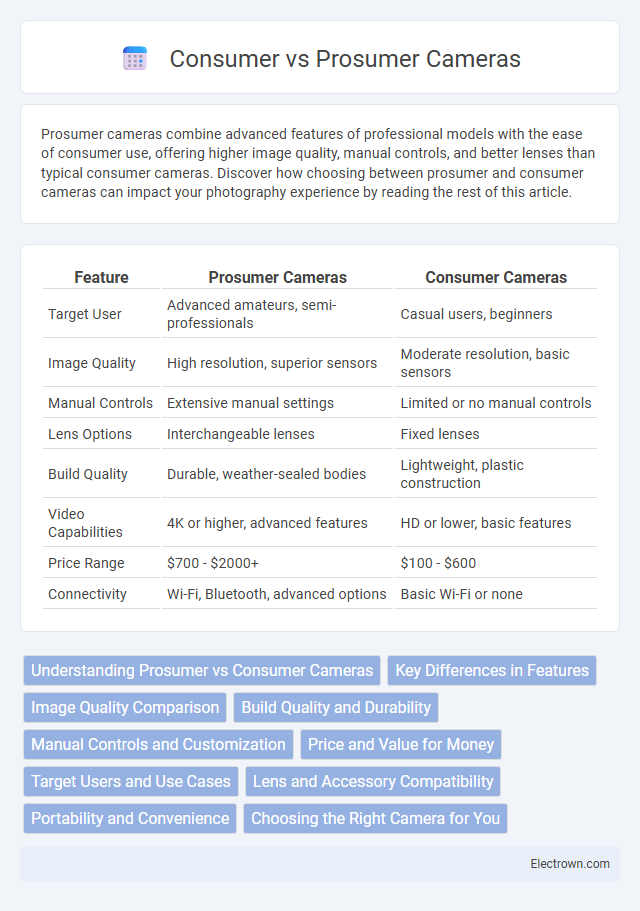Prosumer cameras combine advanced features of professional models with the ease of consumer use, offering higher image quality, manual controls, and better lenses than typical consumer cameras. Discover how choosing between prosumer and consumer cameras can impact your photography experience by reading the rest of this article.
Table of Comparison
| Feature | Prosumer Cameras | Consumer Cameras |
|---|---|---|
| Target User | Advanced amateurs, semi-professionals | Casual users, beginners |
| Image Quality | High resolution, superior sensors | Moderate resolution, basic sensors |
| Manual Controls | Extensive manual settings | Limited or no manual controls |
| Lens Options | Interchangeable lenses | Fixed lenses |
| Build Quality | Durable, weather-sealed bodies | Lightweight, plastic construction |
| Video Capabilities | 4K or higher, advanced features | HD or lower, basic features |
| Price Range | $700 - $2000+ | $100 - $600 |
| Connectivity | Wi-Fi, Bluetooth, advanced options | Basic Wi-Fi or none |
Understanding Prosumer vs Consumer Cameras
Prosumer cameras blend advanced features and manual controls from professional models with user-friendly designs typical of consumer cameras, offering higher image quality and versatility. Consumer cameras prioritize simplicity, affordability, and ease of use, making them ideal for casual photography but often lack the extensive customization found in prosumer options. Understanding these differences helps You choose a camera that matches Your skill level and creative needs effectively.
Key Differences in Features
Prosumer cameras offer advanced features such as larger sensors, manual controls, and superior build quality that bridge the gap between consumer and professional models. Consumer cameras prioritize ease of use with automatic settings and compact designs, making them ideal for casual photography. Your choice depends on whether you need versatility and high image quality or simple, straightforward operation.
Image Quality Comparison
Prosumer cameras offer superior image quality compared to consumer models due to larger sensors, advanced optics, and enhanced image processing capabilities. These cameras typically support higher resolution, better low-light performance, and wider dynamic range, resulting in sharper details and richer colors. Consumer cameras prioritize ease of use and affordability, often sacrificing image quality and manual control features found in prosumer options.
Build Quality and Durability
Prosumer cameras offer superior build quality and durability compared to consumer models, featuring weather-sealed bodies and robust materials designed to withstand rigorous use. Your investment in a prosumer camera ensures long-lasting performance in diverse shooting conditions, ideal for enthusiasts who demand reliability. Consumer cameras, while lightweight and more affordable, often lack the reinforced frames and protective elements found in higher-end models.
Manual Controls and Customization
Prosumer cameras offer extensive manual controls and customization options, allowing you to adjust settings such as aperture, shutter speed, ISO, and white balance for precise image creation. These advanced features provide photographers with greater creative flexibility compared to consumer cameras, which typically prioritize automatic modes and simplified interfaces. Customizable buttons and menu settings on prosumer models enhance your ability to tailor the shooting experience to specific needs and preferences.
Price and Value for Money
Prosumer cameras typically range from $800 to $2,500, offering advanced features like larger sensors, manual controls, and higher video resolutions, delivering superior value for enthusiasts and semi-professionals. Consumer cameras, priced between $300 and $800, provide basic functionality suitable for casual use but may lack the durability and image quality that prosumers demand. Investing in a prosumer camera often results in better long-term value due to enhanced performance and versatility, despite the higher initial cost.
Target Users and Use Cases
Prosumer cameras target advanced enthusiasts and semi-professional photographers who demand higher image quality, manual controls, and versatile features for creative projects, such as event photography, travel, and content creation. Consumer cameras suit casual users prioritizing ease of use, portability, and automatic settings for everyday moments and family snapshots. Your choice depends on whether you need advanced capabilities and customization or simple, quick shooting for personal memories.
Lens and Accessory Compatibility
Prosumer cameras typically offer superior lens and accessory compatibility compared to consumer models, featuring interchangeable lenses that support a wide range of focal lengths and specialized options such as macro, telephoto, and wide-angle. These cameras often include accessory ports and mounts for external flashes, microphones, and filters, enhancing creative control and functionality. Your choice between prosumer and consumer cameras should consider the flexibility required for various shooting environments and long-term equipment investments.
Portability and Convenience
Prosumer cameras typically balance high-performance features with relatively compact designs, offering greater portability than professional DSLR systems yet more advanced functionality than basic consumer models. Consumer cameras emphasize ease of use and lightweight construction, making them ideal for casual photography and travel convenience. The portability of prosumer models suits enthusiasts seeking both quality and mobility, while consumer cameras excel in straightforward handling and compact form factors for everyday convenience.
Choosing the Right Camera for You
Prosumer cameras offer advanced features, manual controls, and superior image quality, making them ideal for enthusiasts and semi-professionals seeking creative flexibility. Consumer cameras prioritize ease of use, compact design, and affordability, perfect for casual photographers or beginners focused on convenience. Evaluating your photography goals and technical skills helps you choose the right camera that fits your needs and enhances your shooting experience.
Prosumer vs Consumer Cameras Infographic

 electrown.com
electrown.com